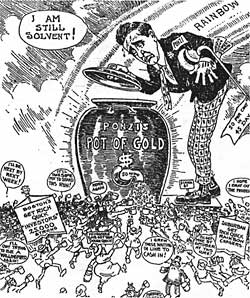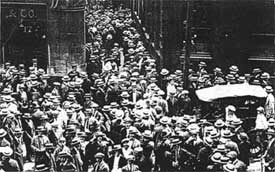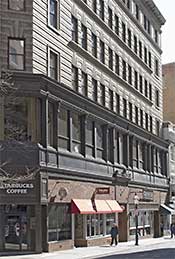Original Ponzi Scheme
 Cartoon poking fun at Ponzi and his get-rich-quick investors3
Cartoon poking fun at Ponzi and his get-rich-quick investors3Boston has long been a center of financial innovation: Home to the second bank in the U.S.,1 birthplace of the modern mutual fund,2 and at 27 School Street (right around the corner from our office) site of the original Ponzi scheme.
Today the term Ponzi scheme refers to the age-old fraud of using one investor’s money to pay another. Usually the fraudster promises a huge profit, hoping it will attract enough money to pay initial investors the expected amount so that they will brag about their gains, bringing in yet more investors to keep things going. Bernie Madoff did this for over 20 years.
Ponzi set up shop at 27 School Street in 1919, offering investors 50% interest after 90 days, later shortened to 45. People flocked to his office. Arriving at work on July 26, 1920 Ponzi found:
“A huge line of investors … stretched from the City Hall Annex, through City Hall Avenue and School Street … up stairways … all the way to my office!”4
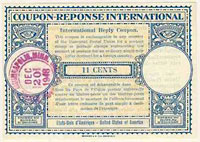
Ponzi claimed that the money to pay these returns came from buying and selling International Postal Coupons and profiting from exchange rate differences. The idea was to purchase coupons with local currency in one country and redeem them in another where the local exchange rate made them more valuable.
Boston newspapers played a central role in both Ponzi’s rise and fall. Stories about 50% returns drew investors; the headline “Declares Ponzi Is Now Hopelessly Insolvent”6 brought them back to get their money.
 Investors in Pi Alley Going to Get Their Money7
Investors in Pi Alley Going to Get Their Money7To allay investors’ concerns, Ponzi offered immediate return of the initial investment to anyone who waived interest (50%). People lined up to get their money (see picture); those who did were paid in full. Confidence was restored and redemption requests stopped after a few days.
 27 School Street Today
27 School Street TodayThe final blow came when a state audit revealed that Ponzi’s debts exceeded assets by $7 million. In the end, he was arrested, convicted and deported as an undesirable alien; several banks failed; investors got 30 cents on the dollar and The Boston Post received a Pulitzer Prize for its exposé.
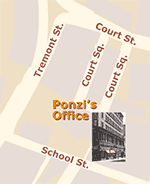
Ponzi’s lasting legacy is his name, which today defines the type of investment fraud he perpetrated.
The building where this all took place still stands at 27 School Street.
-----
- Bank of Massachusetts opened July 5, 1784. For many years known as the First National Bank of Boston, it is today part of the Bank of America.
- Massachusetts Investors Trust, now part of MFS, was the first open-end mutual fund with redeemable shares. Wikipedia.
- Found on-line. Identified as from The Boston Post.
- From Ponzi’s autobiography, The Rise of Mr. Ponzi, 1937.
- International Reply Coupons are still sold today. They can be exchanged for first class postage in any of the 192 countries that are members of the Universal Postal Union.
- The Boston Post, August 2, 1920, p. 1. See front page.
- Photo from the Boston Globe, August 3, 1920, p. 3.
Continue to >> The Way We Were
Beginning of Tour << Start Over


